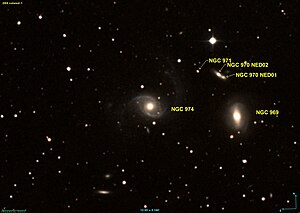NGC 974
| Galaxy NGC 974 |
|
|---|---|

|
|
| AladinLite | |
| Constellation | triangle |
|
Position equinox : J2000.0 , epoch : J2000.0 |
|
| Right ascension | 02 h 34 m 25.8 s |
| declination | + 32 ° 57 ′ 16 ″ |
| Appearance | |
| Morphological type | SAB (rs) b: |
| Brightness (visual) | 12.8 mag |
| Brightness (B-band) | 13.6 mag |
| Angular expansion | 1.7 ′ × 1.2 ′ |
| Position angle | 63 ° |
| Surface brightness | 13.4 mag / arcmin² |
| Physical data | |
| Affiliation | LGG 066 |
| Redshift | 0.015010 ± 0.000023 |
| Radial velocity | 4500 ± 7 km / s |
|
Stroke distance v rad / H 0 |
(206 ± 14) · 10 6 ly (63.1 ± 4.4) Mpc |
| history | |
| discovery | John Herschel |
| Discovery date | November 22, 1827 |
| Catalog names | |
| NGC 974 • UGC 2049 • PGC 9802 • CGCG 505-015 • MCG + 05-07-012 • IRAS 02314 + 3243 • 2MASX J02342577 + 3257160 • LDCE 176 NED017 | |
NGC 974 is a spiral galaxy of Hubble type Sb in the constellation Triangulum at the northern sky . It is an estimated 206 million light years away from the Milky Way and has a diameter of around 100,000 ly.
In the same area of the sky are the galaxies NGC 969 , NGC 970 , NGC 973 , NGC 978 .
The Type Ia supernova SN 2017hju was observed here.
The object was discovered by John Herschel on November 22nd, 1827 .
